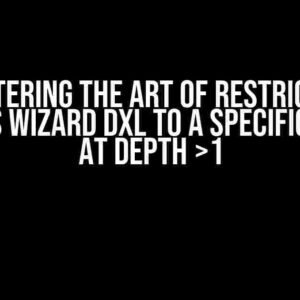Are you tired of encountering the mysterious ArgumentNullException error in Unity when using Linq with WebGL? You’re not alone! This error can be frustrating, especially when you’re close to deploying your game or application. Fear not, dear developer, for we’re about to dive into the depths of this issue and emerge victorious on the other side.
What is the ArgumentNullException Error?
The ArgumentNullException error occurs when you attempt to use a null or empty object reference in your code. In the context of Unity and Linq, this error often surfaces when working with WebGL builds. But why does it happen, and more importantly, how can we fix it?
The Problem with Linq and WebGL
Linq (Language Integrated Query) is a powerful tool for querying and manipulating data in C#. However, when used in conjunction with Unity and WebGL, things can get messy. The issue lies in the fact that Linq relies on .NET’s runtime to execute queries, which is not compatible with WebGL’s AOT (Ahead-of-Time) compiler.
When you build your Unity project for WebGL, the AOT compiler converts your C# code into JavaScript. Unfortunately, this process can lead to errors when using Linq, as the AOT compiler doesn’t fully understand the dynamic nature of Linq queries.
Causes of the ArgumentNullException Error with Linq and WebGL
So, what exactly causes the ArgumentNullException error with Linq and WebGL? Let’s take a look at some common culprits:
- When you attempt to use Linq on a null or empty collection, the ArgumentNullException error will rear its ugly head.
- Certain Linq methods, such as
First(),Single(), orElementAt(), can cause issues with WebGL. - Linq queries that use dynamic or anonymous types can lead to errors when compiled for WebGL.
- Forgetting to include the necessary using directives or using the wrong ones can cause the ArgumentNullException error.
Solutions to the ArgumentNullException Error
Now that we’ve identified the causes, let’s dive into the solutions! Follow these steps to banish the ArgumentNullException error from your Unity project:
Solution 1: Check for Null or Empty Collections
Before using Linq on a collection, ensure it’s not null or empty. You can do this by adding a simple null check:
List<MyObject> myList = GetMyList();
if (myList != null && myList.Any())
{
var result = myList.Where(x => x.IsValid).ToList();
// Process the result
}
By using the Any() method, we can safely determine if the collection is empty or null.
Solution 2: Avoid Incompatible Linq Methods
Avoid using Linq methods that are known to cause issues with WebGL, such as First(), Single(), or ElementAt(). Instead, opt for methods like Where(), Select(), or ToList().
Solution 3: Use Compatible Linq Queries
When writing Linq queries, stick to compatible methods and avoid dynamic or anonymous types. For example:
var result = from item in myList
where item.IsValid
select item;
This query uses a compatible method (where) and avoids dynamic types.
Solution 4: Include Necessary Using Directives
Make sure to include the necessary using directives in your script:
using System.Collections.Generic;
using System.Linq;
These directives will ensure that you have access to the necessary Linq methods.
Best Practices for Using Linq with WebGL in Unity
To avoid the ArgumentNullException error and other Linq-related issues in your Unity project, follow these best practices:
- Stick to Linq methods that are known to work with WebGL, such as
Where(),Select(), andToList(). - Steer clear of dynamic or anonymous types in your Linq queries.
- Always check for null or empty collections before using Linq.
- The LINQPad debugger is a fantastic tool for testing and debugging Linq queries.
- Thoroughly test your code in both the Editor and WebGL builds to catch any potential errors.
Conclusion
The ArgumentNullException error in Unity using Linq with WebGL can be a daunting issue, but by following the solutions and best practices outlined in this article, you’ll be well on your way to resolving the problem. Remember to always check for null or empty collections, avoid incompatible Linq methods, and use compatible queries.
By being mindful of these potential pitfalls, you’ll be able to harness the power of Linq in your Unity project, ensuring a smooth and error-free development process. Happy coding!
| Keyword | Description |
|---|---|
| ArgumentNullException | An error that occurs when using a null or empty object reference in code. |
| Linq | Language Integrated Query, a powerful tool for querying and manipulating data in C#. |
| WebGL | A platform for building and deploying web-based applications, including games. |
| AOT Compiler | Ahead-of-Time compiler, which converts C# code into JavaScript for WebGL builds. |
Here are the 5 Questions and Answers about “ArgumentNullException error in Unity using Linq with WebGL”:
Frequently Asked Question
Stuck with ArgumentNullException error in Unity while using Linq with WebGL? Don’t worry, we’ve got your back! Here are some frequently asked questions to help you troubleshoot the issue:
Q1: What is the ArgumentNullException error in Unity, and why does it occur when using Linq with WebGL?
The ArgumentNullException error in Unity occurs when a method is called with a null argument. In the context of Linq with WebGL, this error can occur when the input sequence is null or empty. This can happen when the data source is not properly initialized or when the WebGL platform does not support certain Linq operations.
Q2: How can I check if the input sequence is null or empty before using Linq operations in Unity?
You can use the null-conditional operator (?.) or the null-coalescing operator (??) to check if the input sequence is null or empty before using Linq operations. For example, you can use `mySequence?.Where(predicate)` or `mySequence ?? Enumerable.Empty
Q3: Are there any specific Linq operations that are not supported in WebGL, which can cause the ArgumentNullException error?
Yes, some Linq operations are not supported in WebGL, such as those that use reflection or dynamic methods. Operations like `Queryable.FirstOrDefault()` or `Enumerable.SelectMany()` can cause issues in WebGL. It’s essential to test and validate your Linq operations on the target platform to ensure compatibility.
Q4: Can I use try-catch blocks to catch the ArgumentNullException error in Unity when using Linq with WebGL?
While try-catch blocks can catch the ArgumentNullException error, it’s not the most efficient or elegant solution. Instead, focus on validating your input sequences and using guard clauses to prevent null references from propagating through your code. This approach will help you write more robust and reliable code.
Q5: Are there any alternative approaches to using Linq in Unity that can avoid the ArgumentNullException error when targeting WebGL?
Yes, you can use alternative approaches like using Unity’s built-in APIs, such as `List


